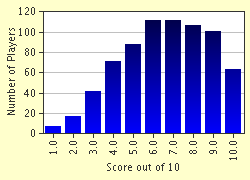Quiz Answer Key and Fun Facts
1. Which of the following prefixes represents 10 raised to the power of -15?
2. Which of the following is a representation of an electric charge?
3. Which one of the following is an active element?
4. Which one of the following could be used to represent the units of conductance(G)?
5. What law is described by the following equation: Voltage(v) = Current(i) x Resistance(R).
6. Which one of the following equations could be used to calculate the power absorbed by a resistor?
7. If three resistors, R1=50.0 kOhm, R2=50.0 kOhm and R3=25.0 kOhm, are placed in parallel, what resistor (Re) could be used to represent an equivalent resistance?
8. If three resistors, R1=50.0 kOhm, R2=50.0 kOhm and R3=25.0 kOhm, are placed in series, what resistor (Re) could be used to represent an equivalent resistance?
9. What law is used when evaluating a circuit using the Node Voltage method?
10. What is the method of analyzing a circuit containing multiple independent sources by activating one source at a time?
Source: Author
SmilingFaces
This quiz was reviewed by FunTrivia editor
crisw before going online.
Any errors found in FunTrivia content are routinely corrected through our feedback system.

